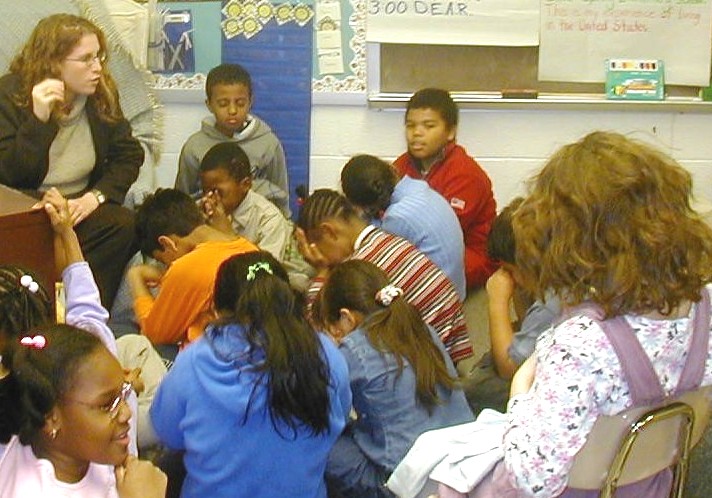| The Kid 'Lobby' Proving
Strong in Annapolis

|
Teacher Nina Rubin (standing rear) and East Silver Spring
Elementary third-graders (Photo by Gloria Son)
|
By Gloria Son
Maryland Newsline
Friday, Feb. 15, 2002
First a group of Maryland grade-schoolers
successfully argued for a state dinosaur – the Astrodon johnstoni
– in 1998.
Then some other tykes helped push through a
state feline, the calico cat, in 2001.
Now some Silver Spring third-graders are asking
Maryland legislators to turn walking into the state exercise.
They
may not be old enough to vote -- or even watch a PG-13 movie
unsupervised -- but kids are proving they’ve got enough clout to influence votes
in Annapolis.
Legislators admit they did not take
the students’ ideas for new symbols seriously at first. But once they spoke to the
children and saw their enthusiasm, they were hooked, they said.
“I’ll be honest with you. When I
saw the [calico cat] proposal, I thought, ‘Oh, boy,’ ” said
Del. Kevin Kelly, D-Allegany, of the letter he received from a group
of Westernport Elementary School girls.
So he let the note sit in his files.
But as time passed and he started
getting more letters from the five fifth graders, Kelly knew they
were determined to see this through.
“Within three hours of the time that
I filed that bill, I realized that it was something special,” he
said. “Instantaneously, it became a point of interest with the
press.”
He said he also learned how many
serious animal lovers there are in the state.
“It was the most pleasurable,
enjoyable experience,” Kelly added of his experience with the
children.
Perhaps it’s because, unlike most
professional lobbyists, the kids weren’t seeking monetary rewards. “They
don’t get anything out of it except satisfaction, education and
the knowledge that they can effectuate change,” said Sen.
Nathaniel McFadden, D-Baltimore.
Melissa Gersh, a third-grade teacher
at East Silver Spring Elementary, is using the exercise bill efforts
as part of a letter-writing
curriculum for her class.

|
Melissa Gersh reads a book to her third-grade students. (Photo by Gloria Son)
|
“The students learned that when you
write a letter, you can make a difference,” she said. “We
provided them with a real-life experience.”
Roughly 90 third-grade students
wrote to Delegate William A. Bronrott, D-Montgomery, and Sen. Ida G.
Ruben, D-Montgomery, asking them to sponsor the walking bill, teacher
Nina Rubin said. Both responded, and Bronrott ended up
sponsoring it, Rubin said.
Kelly, McFadden and Bronrott all said
they were nervous about how their colleagues would react to
legislation sparked by kids. All three said they have been teased or
ridiculed for sponsoring “petty” bills.
But Kelly said he thinks the people
who belittle the bills have an excessive sense of self-importance.
“It’s a callous, insensitive slap across the face of the kids
across the state,” he said.
And he said his sponsorship hasn’t
taken him from other legislative duties. He said he worked on the
calico cat bill during his free time.
Maryland Senate President Thomas V.
Mike Miller Jr. said his initial reactions to the state symbol bills
were “not positive, because we have so many very, very important
issues to deal with.” However, he said, after considering the
positive effect their passage would have on educating young people,
he ended up supporting both the state dinosaur and the state feline
bills.
“I perceive these issues as a
constituent service” that will benefit current and future
students, Miller said.
But how much is all this good will
costing taxpayers?
A
spokeswoman at the state’s Department of Legislative Services’
policy analysis office said a preliminary study conducted about five
years ago showed the cost of processing one bill runs a
little more than $500 on average.
Practically speaking, creating state
symbols may not directly affect Marylanders’ lives. But that’s
not their point, legislators said.
It’s more about the students
learning the legislative process.
“It’s great that young people
understand early on that they can influence public opinion and
public law,” McFadden said. “It’s also good for our democracy.
The earliest someone learns the process, the more they’ll continue
to participate in it in the future.”
Copyright © 2002
University of Maryland College of Journalism
Top of Page | Home Page
|